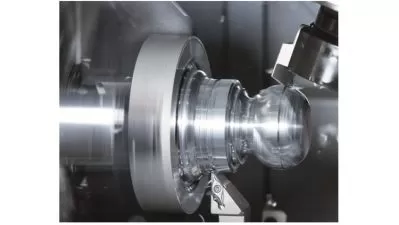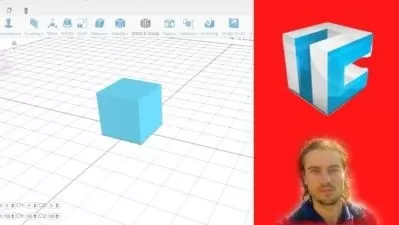OpenFlows StormCAD and CivilStorm - AulaGEO
AulaGEO Academy
2:46:00
Description
Beginner's guide to Bentley Open Flows Storm, applicable to StormCAD, Bentley Civil CivilStorm
What You'll Learn?
- StormCAD
- Civil Storm
- Storm water management
- You will move one step further to design and analyze the system for optimal tailwater conditions and hydraulic jump occurrences.
- Fundamental knowledge of how to lay out a storm sewer network
- Build a model from ESRI Shapefile data
Who is this for?
What You Need to Know?
More details
DescriptionThis is a beginner's guide to Bentley Open Flows Storm. This course is applicable to both StormCAD and Bentley CivilStorm.
It has three exercises where you can follow the video tutorial, utilize the attached resources, and practice well.
About this software for water modeling and analysis
You can analyze pressure and free-surface flow conditions for networks of channels and closed conduits, model complex pond outlets for a variety of tailwater conditions. The software is specialized in design the most cost-effective pipe sizes and invert elevations and too for detect system bottlenecks, improve capacity, and limit stormwater flooding.
First exercise.
The student will obtain a fundamental knowledge of how to lay out a storm sewer network. Components to be placed in this user built model include: catchments, catch basins, pipes, junctions, and an outfall.
You will be stepped through the entry of storm data, Intensity Duration Frequency Curves (IDF), for various storm events. #AulaGEO
Once built, you will then analyze the system based on profile data, FlexTable output, and color coding visuals.
Exercise Setup
Network Layout
Catchment Layout
System Data
Storm Data
Batch Run and Review Results
Annotation
Review Exercise
Second excercise.
You will move one step further to design and analyze the system for optimal tailwater conditions and hydraulic jump occurrences.
Exercise Setup
Background and Prototypes
Network Layout
Entering Date
Alternatives
Scenarios
Model Calculation
Reviewing Results
Third exercise.
Will teach how to build a model from ESRI Shapefile data. It will take you step by step through the ModelBuilder wizard. After the model is built, it willl then step you through the entry of rainfall data for storm events.
It will guide the you through the Terrain Extractor (TRex) tool to add surface elevations to the network. Finally, you will design and test the storm sewer system model for compliance against several design constraints.
Exercise Setup
Model Builder
Data Input
Trex
Design Constraints and Calculation
System Redesign
Scenario Comparison
Exercise Review
Who this course is for:
- Civil engineers
- GIS users
- Hidrology proffesionals
- AutoCAD software users
- Microstation software users
This is a beginner's guide to Bentley Open Flows Storm. This course is applicable to both StormCAD and Bentley CivilStorm.
It has three exercises where you can follow the video tutorial, utilize the attached resources, and practice well.
About this software for water modeling and analysis
You can analyze pressure and free-surface flow conditions for networks of channels and closed conduits, model complex pond outlets for a variety of tailwater conditions. The software is specialized in design the most cost-effective pipe sizes and invert elevations and too for detect system bottlenecks, improve capacity, and limit stormwater flooding.
First exercise.
The student will obtain a fundamental knowledge of how to lay out a storm sewer network. Components to be placed in this user built model include: catchments, catch basins, pipes, junctions, and an outfall.
You will be stepped through the entry of storm data, Intensity Duration Frequency Curves (IDF), for various storm events. #AulaGEO
Once built, you will then analyze the system based on profile data, FlexTable output, and color coding visuals.
Exercise Setup
Network Layout
Catchment Layout
System Data
Storm Data
Batch Run and Review Results
Annotation
Review Exercise
Second excercise.
You will move one step further to design and analyze the system for optimal tailwater conditions and hydraulic jump occurrences.
Exercise Setup
Background and Prototypes
Network Layout
Entering Date
Alternatives
Scenarios
Model Calculation
Reviewing Results
Third exercise.
Will teach how to build a model from ESRI Shapefile data. It will take you step by step through the ModelBuilder wizard. After the model is built, it willl then step you through the entry of rainfall data for storm events.
It will guide the you through the Terrain Extractor (TRex) tool to add surface elevations to the network. Finally, you will design and test the storm sewer system model for compliance against several design constraints.
Exercise Setup
Model Builder
Data Input
Trex
Design Constraints and Calculation
System Redesign
Scenario Comparison
Exercise Review
Who this course is for:
- Civil engineers
- GIS users
- Hidrology proffesionals
- AutoCAD software users
- Microstation software users
User Reviews
Rating
AulaGEO Academy
Instructor's Courses
Udemy
View courses Udemy- language english
- Training sessions 29
- duration 2:46:00
- Release Date 2024/07/22












